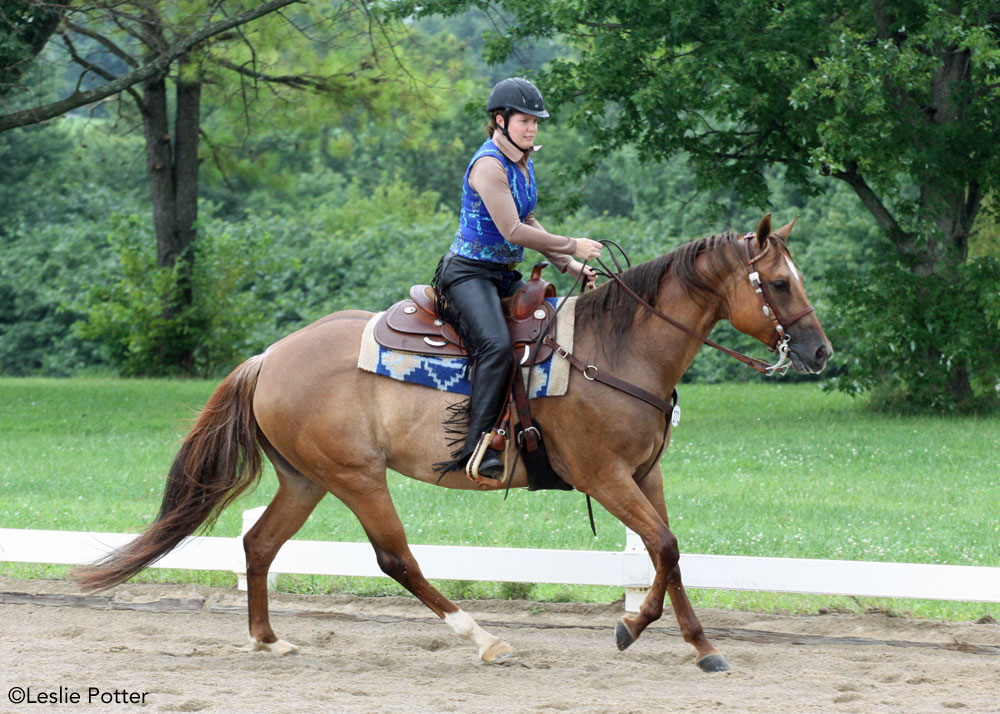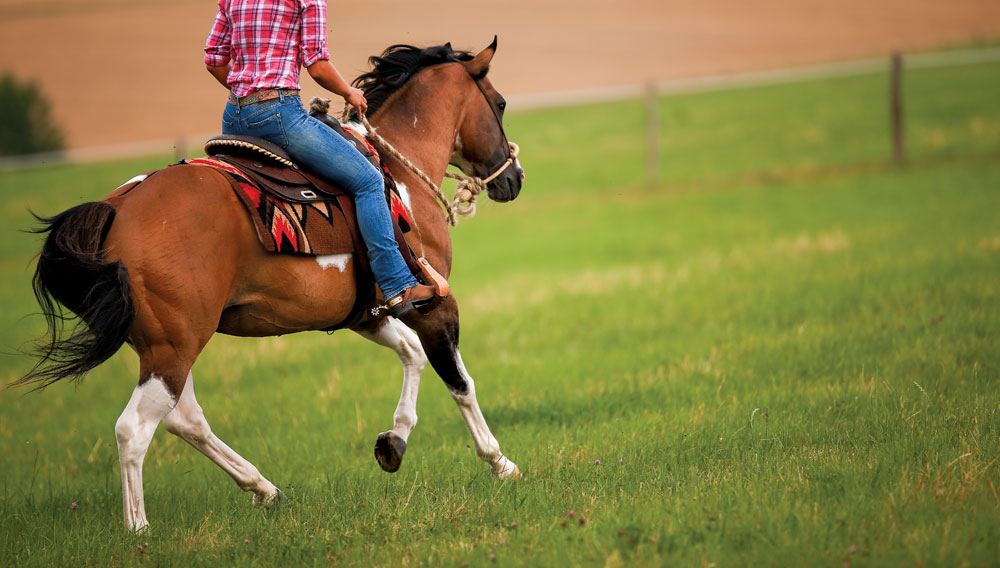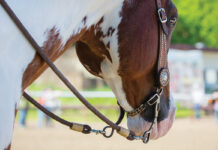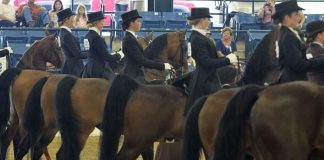Cantering. One word can return images of freedom and adventure or fear and even panic. Here, we’ll talk about the canter cue and how to avoid frustration when your horse takes the wrong lead.

At the canter, your horse should step so that his inside legs reach ahead—appearing to “lead” the horse. This leg arrangement helps him to keep his balance as he turns corners. Your horse first pushes off with his outside hind leg. He then moves his inside hind and outside front legs forward at the same time. One stride of the canter ends when the horse’s inside front leg reaches far forward then leaves the ground.
You’ll conquer the canter when you set up your cue so your horse knows how you want him to move. I’ll help you prepare for the lead you want, making sure you put your horse in position to take off with the correct leg first.
Canter Cues
Here’s how I cue my horses to canter when I’m cueing from the stand still, walk or trot:
- Apply pressure with your outside leg placed about 6 inches behind the girth. This moves the horse’s haunches in.
- Slightly elevate your inside rein (to balance the horse and lift his inside shoulder).
- Make a kissing sound.
- Curl your hips in the canter motion.
Cueing Mishaps
What causes a horse to take the wrong lead? Your horse may not pick up the lead you wish if he doesn’t have a specific cue. Make sure that you give your horse a cue for direction as well as for speed. However, some horses haven’t been trained to pick up a specific lead.
A horse that is used to moving straight ahead, like down a trail, may have been allowed to take his preferred lead. If the cue to canter is associated with something else, like team roping, the horse may learn to start on the left lead since he knows he will be turning left. Also note that if your horse has a past injury or current pain, he may favor one lead. Past pain may cause a horse to habitually choose one lead. Consider having your veterinarian check for physical causes if your horse seems resistant to one lead.
If a horse picks up the wrong lead while traveling in both directions, chances are he doesn’t have a clear signal from the rider. Consider how you positioned him before asking for speed.
Moving In
In the language of classical horsemanship, you can cue your horse to canter with “lateral aids” or “diagonal aids.” Diagonal aids refer to using your outside leg and inside rein as part of your cue (so the aids are applied diagonally). Lateral aids refer to using your outside leg and outside rein (the aids are applied on one side of the horse).

Diagonal aids are used in classical training (such as for dressage), but you often see young and green horses cued with lateral aids. Both types of cues are used to move the horse’s haunches in toward the middle of the arena.
With diagonal aids, you bring the horse haunches-in by arcing in the direction of the turn, which is more technically correct. With lateral aids, you displace the haunches to the inside by turning the horse’s nose to the outside.
Set up for Success
I like to cue my horses to move their haunches to the inside before cantering. This position allows my horse to push off with the correct outside leg when I cue for the canter.
Once I’m in position, I must sequence my cues and make sure that I always cue in a consistent order. I want to give my horse as much information as possible so that he’ll move exactly how I ask him to. Horses can learn sequences quickly, so the more you can incorporate a slow and consistent sequence of cues, the faster he will learn to step off into the lead you want.
If you rush your cues or apply more than one at a time, you may rush your horse and not get the result you want.
I sequence my cues and separate them by a half a second or more. If you rush your cues or apply more than one at a time, you may rush your horse and not get the result you want. Make sure your horse is warmed up and attentive before giving him your sequence of canter cues.
Think through the sequence that you use, then make a one-syllable reminder for each part of the sequence. I repeat the phrase “Leg-Rein-Kiss-Push” over in my mind to help me prepare for the sequence. Say the cue in your head in a 1-2-3-4 rhythm as you cue. Take all the time your horse needs. Do not cue until your horse is ready and slow down the cue if your horse struggles or doesn’t do as you’ve asked. A young or green horse (or a horse that is unfamiliar with you as the rider) may need a slow cue sequence so he has the best chance to understand and comply.
For smooth transitions to the canter from the halt, walk or trot, the horse needs to be collected and attentive in order to step off promptly and smoothly into the canter. You don’t want your horse to blast into the canter. Cantering from the halt or walk generally requires a higher level of training for both horse and rider and comes later in the horse’s training.
Tips and Training Plans
Pick the best spot in the arena to ask your horse for the canter lead you want. For green horses or horses that won’t take one lead, I like to cue just before turning to the short side of the arena. Make sure not to cue the horse in the turn, but just before it.
At the perfect cueing spot, your horse will be moving straight on the long rail. In this spot, he’ll most easily accept the cue for haunches in and he will see the upcoming turn and know which way he will turn. If you wait until your horse is already in the turn, his haunches will drift to the outside, causing him to take the wrong lead.
Slow down your training and give your horse the best chance to understand your cues.
If taking the correct lead is still a challenge, practice the haunches-in position at the walk and trot without asking for the canter. Leg-yielding is also a good way to develop better control of the haunches. Slow down your training and give your horse the best chance to understand your cues. Keep in mind that all of training occurs in transitions. Your departures will only get better by doing lots of transitions.
Make sure that you don’t get into a pattern as you practice your canter cue (always doing it at the same spot or same time in your ride, stopping at the same place or after the same number of strides). Your horse will learn to anticipate instead of listen to your precise cue. Do two or three departures on each lead during your rides and you’ll make progress without overworking or drilling your horse.
Coming up next in Part 2, Julie will help you avoid breaking gait. In Part 3, she’ll troubleshoot common canter issues—fear and bucking at the canter.
This article about cueing the canter originally appeared in the April 2018 issue of Horse Illustrated magazine. Click here to subscribe!





